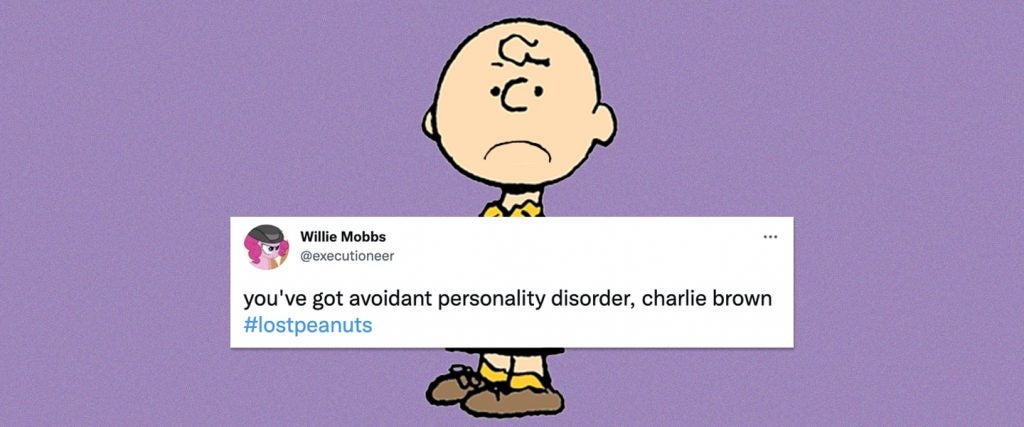Of all the armchair psychological diagnoses doled out to cartoon characters, Charlie Brown seems to get a disproportionate amount of them. But instead of getting labeled with major depressive disorder or social anxiety disorder, the lovable sad boy appears to have a lesser-known affliction: avoidant personality disorder or AvPD. At least, that’s according to Twitter.
Although AvPD is thrown around with ease among Peanuts enthusiasts, it’s much more difficult to pin down in real life as many experts believe it’s an underdiagnosed disorder. On the surface, it looks a lot like being shy or socially awkward. However, the symptoms of low self-worth, isolation and fear of rejection are far more severe and difficult to treat, clinical psychologist Kristine Dahl Sørensen explains. “Avoidant personality disorder is one of the most common personality disorders with potentially grave consequences and suffering for those who struggle with the psychological and social challenges associated with it,” Sørensen, who studies AvPd, tells me.
Socially awkward people also fear rejection, but for those with AvPD, that same fear is paired with an irrational sense of certainty that they’re lesser human beings, even when their experiences don’t validate it. Unfortunately, this belief also makes it that much harder to convince them that they’re worthy of getting help. “AvPD is hard to explain to others, and people often don’t seek treatment as they feel nothing can be done about it,” says Lisa Lampe, a psychiatrist and associate professor at the University of Newcastle Australia. “This is terribly sad because in reality almost everyone I’ve ever met who has AvPD is a sensitive, caring, likable person.”
In some ways, avoidant personality disorder might sound like depression, but again what distinguishes AvPD is how pervasive the symptoms are. For instance, while people with mood disorders like bipolar disorder experience episodes of depression, people with personality disorders like AvPD feel unworthy all the time, Sørensen notes. However, some people with AvPD “may also present their state as being depressed as they describe their despair,” Sørensen says. And like depression, AvPD has been linked with an increased risk for substance abuse and suicidal ideation, making diagnosing it that much more more complicated. (Complicating matters further, Sørensen confirms that it’s entirely possible and common to have both AvPD and depression.)
As for what causes AvPD, “current research suggests there’s a complex relationship between genes, temperament, early childhood environment, attachment style and personality in avoidant personality disorder,” therapist Brooke Harris tells me. “Early childhood experiences such as perceived or experienced neglect or lack of affection from caregivers, anxious and avoidant attachment style and temperaments such as personality rigidity, hypersensitivity and high harm avoidance can all be considered examples.”
Given the labyrinth nature of personality disorders, people should resist the urge to self-diagnose and talk to a mental-health professional instead. But if you’re worried, another good way to tell the difference between awkwardness and avoidant personality disorder is that people with AvPD are “often more comfortable with strangers actually,” Lampe explains. “There’s no fear of seeing them again and then deciding that the individual is somehow not good enough, and then being rejected.” Another tell is leaving jobs and romantic relationships in the first few months at “the getting to know you stage.”
In the end, living with avoidant personality disorder differs pretty significantly from just being a socially awkward human. In terms of the Certified Twitter Psychologists who think they know where Charlie Brown falls on this spectrum, to quote the lovable loser himself, good grief!

